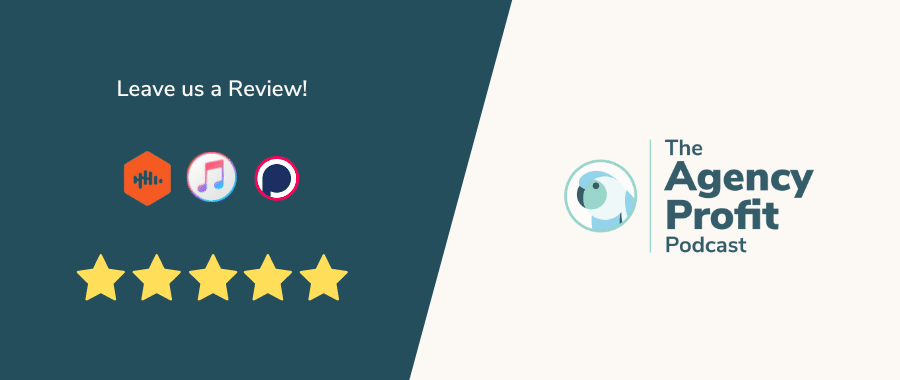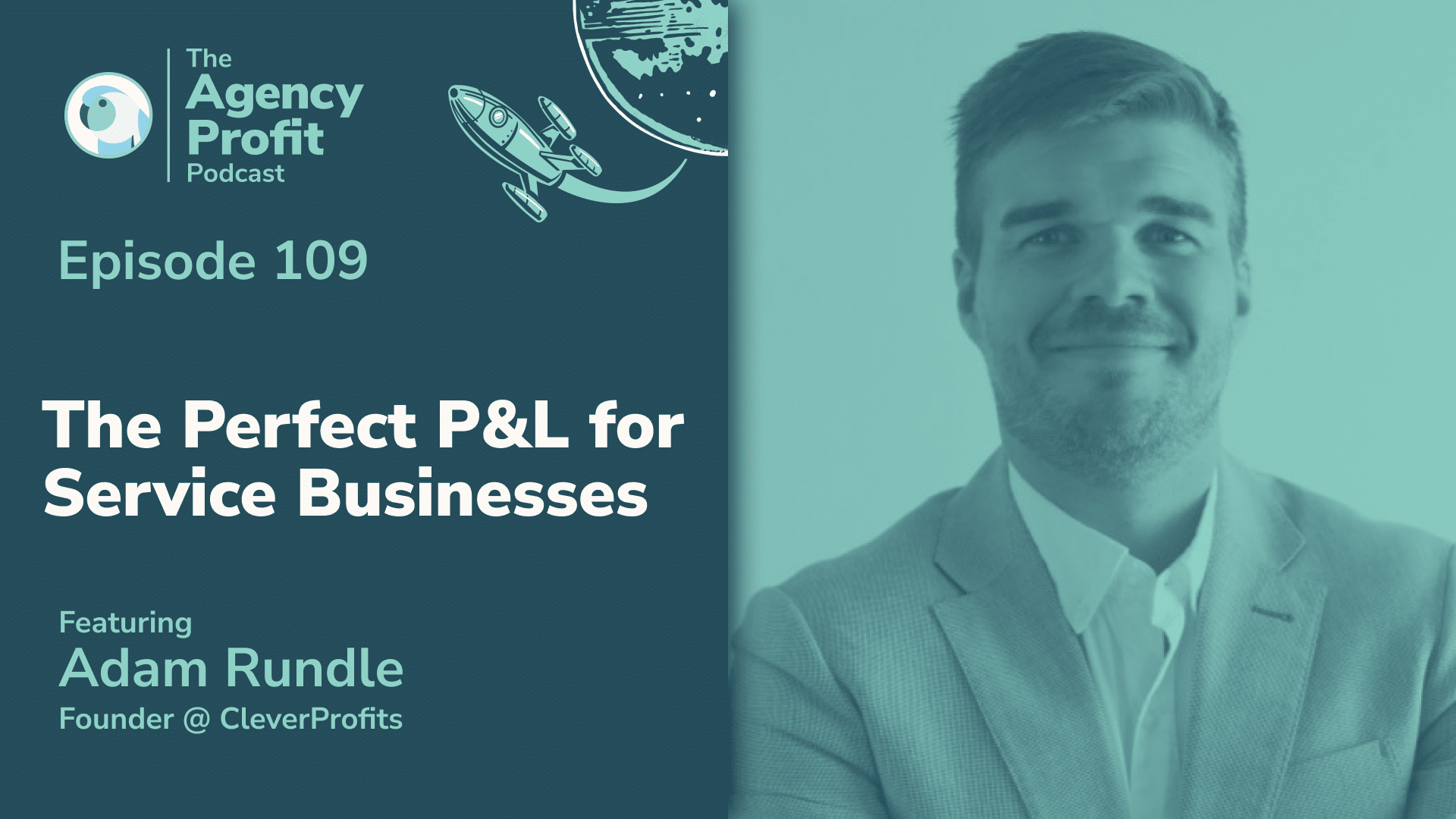This week, Marcel chats with Adam Rundle (founder and CEO of CleverProfits) about the optimum P&L plus how best to comprehend and navigate your agency’s financial metrics.
About Adam Rundle
Adam and his team at CleverProfits build and implement world-class financial frameworks for fast-scaling online businesses.
Through CFO services, his talented cohort of Chartered Accountants, Advisors, and Financial Experts bridge the gap between your company vision and tangible goals plus projections. Ultimately, this helps to ensure you get where you want to go, even if you don’t know the “how” to get there!
By walking alongside you, CleverProfits remove the financial complexity of when to invest in the right opportunities, enabling you to dedicate your creativity and energy to business areas that matter most to you.
When Adam isn’t guiding agency owners on their path to success, he’s been heavily involved in coaching rugby for the past 15 years, most notably coaching at the US Naval Academy until June 2022.
Points of Interest…
- How CleverProfits aids Agency Owners with Financial Metrics 1:24
- How Adam Devised the “Perfect” P&L 7:19
- Methodology Behind the Perfect P&L 10:32
- There is No Right Vs Wrong in Financial Metrics 12:19
- Fixed Vs Variable Overhead 18:40
How CleverProfits Aids Agency Owners with Financial Metrics
Having moved to the states six years ago from his native South Africa, Adam set up CleverProfits with a view to helping business owners truly make money that they can extract from their business and invest in their lives.
“Everyone’s got their own vision, and what they want to do, and we don’t get involved in that. We simply get involved in the business side and say, ‘Hey, how can we help you build a highly profitable, highly efficient, highly well-run machine that can truly derive you some form of income that is tangible’.”
CleverProfits is centered around conventional accounting firm-esque services, such as bookkeeping account services, fractional CFO services, taxes, payrolls, and hr predominantly for digital marketing agencies and online service-based businesses.
Essentially, Adam is in the business of buying time from people and reselling it at a profit. There are lots of clever ways of packaging that up so you’re not directly discussing time with clients, but – ultimately – that’s the business model!
With this in mind, I’m eager to ask Adam how that has informed the way in which he looks at structuring financial data for these service-based businesses…
“To me, the methodology around finances is pretty simple – in fact, it’s got to be really simple – because the accounting industry is very technical. You are required to have a significant level of education in order to participate and there are a lot of barriers with that. And, unfortunately, I feel accountants in the past have kind of enjoyed that intellectual barrier… I think that that model’s falling away over time.”
In Adam’s experience, entrepreneurs and business owners are becoming a lot savvier, and this is where his point regarding simplicity is key. Based on the nature of who it is, and the nature of it, Adam’s aim is to extract and highlight the key data (from all the tons of other data) so you can create a simple system structure that gives you the required key data points in an easy, concise manner as quickly as possible.
“The analogy I often use is this; you don’t walk into a doctor’s office if you’re feeling sick and ask for an MRI. There’s a process beforehand where you’re examined, your vital signs are checked, etc. We’re that initial assessment – that very quick, inexpensive assessment that has to come first. It’s about creating a couple of very key buckets that we believe are the key drivers, and then center the methodology around those.”
***More on this from 5:37 minutes***
How Adam Devised the “Perfect” P&L
Now that we’ve addressed the fact that the rigidity often imposed within the accounting industry doesn’t always initially apply, let’s move on to the key elements of the perfect P&L. What is behind Adam’s methodology?
“When I started this company and was booking a couple more clients, I was looking at these financials and thinking – ‘OK, I’m measuring things, but I don’t actually know whether it’s good or bad.’ This was because it was so subjective.”
As a result, it was tricky to gauge how effective employees were being, or even ascertain if the business model was working. This is how limiting only having the bottom line profit number is in terms of growing your business. Simply put; if you can only see that you’re making 20% or 30% profit margin, how are you ever going to improve that number if you don’t know how to bolster the numbers that came before it?!
“I read a book called Simple Numbers, Straight Talk, Big Profits by Greg Crabtree, which was massive in the forming of my opinions and viewpoints of how to do this. I also read Mike Michalowicz’s Profit First, as well as researching and doing analytics. This led to the formulation of what I believe to be the perfect P&L.”
As for what it entails; Adam states that depending on the type of business you run, there are certain metrics that you need to be within in order to maximize your profit margin.
“The max profit margin we aim for everyone is 30% and 30% is a high number. The reality is, most people average between 20% or 25% and sometimes even lower, perhaps 15 to 20% – which is fine. It’s called the perfect P&L because we are aiming for perfection.”
In other words, we’re not saying you want to achieve perfection every single time, but you need to put the yardstick at the highest level in order to manage the rest.
Side note: our Agency Profit Toolkit is a one stop shop for you to be able to outline some of these crucial profitability numbers to a potential buyer. Spreadsheets, templates and training videos, you name it, it’s all in the toolkit. Grab yours free at the link below:
Methodology Behind the Perfect P&L
The Perfect P&L is also built around sustainability; it’s more than just running your business. When you’re experiencing hypergrowth, your margins will decrease because you are going faster and expending more energy.
“We work with a lot of businesses that are actively trying to grow very heavily. Most startups and small businesses are. No one’s really saying, ‘Well, I’m gonna plateau for the year!’ They’re REALLY trying to grow and we naturally see that profit margin decrease.”
With this in mind, Adam and his team break down the drivers into three key areas in their model thusly…
- Acquisition
- Labor/fulfillment – what is the cost of all the human resources in order to deliver the service product, whatever it is that you are trying to deliver.
- Overheads – the things required to run your business.
While those are the three major buckets, obviously every single one of them has an array of subcategories. That said, everything roles up to one of those three buckets and Adam formulated how best to allocate money correctly to said buckets to maximize that 30% profit.
“From there you can start to break down point two – Labor. Where does it go? You know, is it operations, marketing, success services, some other delineations? So that is the general idea behind the Perfect P&L.”
There is no Right Vs Wrong in Financial Metrics
Full disclosure; Adam and I had a conversation before we hit record on this, and we established that we don’t see eye to eye on the details of how this should be structured. That said, we are (so far) strategically aligned on everything that Adam has said in terms of the following…
- Focusing just on the bottom line is not adequate
- What your ratio of labor is
- The discussion to be had around Gross Margin
- It matters how efficient your delivery is
- The quality of your revenue also matters and separating the costs/drivers therein
And, to Adam’s point (at 13:35) there is no “right and wrong.”
“If the argument is, which is right or wrong, I think we have the wrong argument… I will never say the Perfect P&L is the right way. No, the Perfect P&L is a way – it’s the way we like to do it. It’s the way we understand and interpret finances.”
In other words, what methodology you use is irrelevant – rather it all boils down to using your chosen methodology effectively and consistently. Understand why and how it works for you. Make sure you build the entire system around it so that it’s got congruency from start to finish. Execute it well, and you will succeed.
Again, most of the clients that come to us at Parakeeto believe they’re suffering from starvation when they’re actually experiencing indigestion. It all looks the same, however, on their P&L because they’re ONLY looking at the bottom line.
***I delve into differentiating between the two (and my “ideal” ratio) from 15:54***
Fixed Vs Variable Overhead
There’s a concept I’m curious about involving fixed versus variable overhead which I’m keen to get Adam’s input on as I don’t see it defined often. How does he differentiate those things and why does he split them out that way?
“Technically, have three overhead buckets that fall under one big overhead category – those being Fixed Overheads, Variable Overheads, and Business Development. What can be deemed fixed and variable? We don’t overly obsesses over those; to us the combination of all overheads is the most important number.”
OK, so how does Adam and his team view these three categories? Let’s break it down.
- Fixed Overheads: rent, software, insurance, and utility.
- Variable Overheads: pretty much everything else in your business that could potentially exist, obviously outside of labor and acquisition costs.
- Business Development: this is deemed the business owner bucket. So things like travel, meals, training, and education. Why put such things under BizDev? Well, in Adam’s view, sometimes there could be a high discretionary level of spend there because of a desire of a business owner to invest in their growth in a tax-effective way ***further insight on this from 19:50***
So much of CleverProfits’ analysis surrounds the combination of the above three categories NOT exceeding much more than 15%. In fact, Adam doesn’t want them – as a combination – to exceed much more than 50%.
“Then – like I said before – if you progress to doing MRIs, you’re diving deeper, then you can start to look and say ‘Hey, this number looks higher, this one looks lower… What we do fundamentally believe is that software, rent, insurance, and utilities are consistent in a business.”
***We nerd out on some number around this from 21:05, as well as the concept of “precision versus accuracy” from 22:20***
Key Takeaway…
As Adam points out, we could have a 14 hour podcast trying to ultimately define Fixed and Variable as it pertains to each business and that is why, dear readers, no one really gives a flying hoot – just understand your chosen P&L model and have fun with it.
See more from Adam…
Did you learn anything new from this episode? Let us know in the comments below! We have helpful blogs designed to bolster your agency profitability, such as How To Calculate Your Billable Employee Cost-Per-Hour.
Our next installment of #APP, on April 5th, will see Marcel chat with Brent Weaver for our 110th edition. Our previous blog – Episode 109 with Karsten Rasmussen – can be viewed here…
Avid #APP Listener?!
We would be eternally grateful if you could leave us a review…

Agency Profitability Tool Kit
If you’re looking for more resources to help you improve your agency’s profitability, check out the Agency Profitability Tool Kit. It’s full of templates and checklists used when consulting clients. This helps them improve profitability by over 100% in under 60 days.
Fill out the form below for your copy!






0 Comments